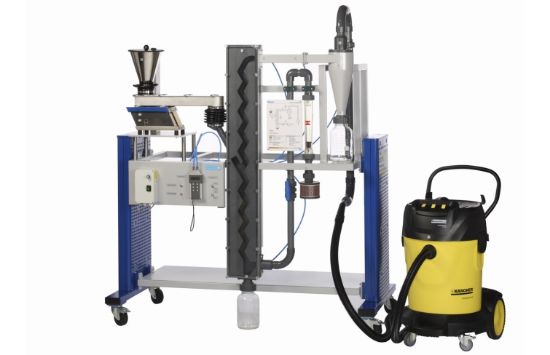The GUNT Gas Flow Classification Trainer demonstrates the separation of solid compounds based on particle geometry and density using a vertical zigzag sifter. Solid material is introduced at mid-height via a vibrating trough, and an upward air flow carries lighter particles while heavier particles fall. Each bend in the 20-stage transparent zigzag duct acts as a sifting stage, generating vortex wakes for crosswise particle movement. This setup allows highly refined classification. A fan provides adjustable airflow, and the fine material is collected in a cyclone. Pressure measurement points are integrated for monitoring system pressure losses.
Product Features
- Gas flow classification using a 20-stage vertical zigzag sifter
- Solid feed via vibrating trough at mid-height for effective separation
- Upward airflow carries fine particles, heavier ones fall by gravity
- Each bend in the zigzag duct provides a transverse sifting stage
- Transparent construction for clear observation of classification behavior
- Airflow generated by integrated fan with adjustable volumetric rate
- Adjustable solid mass feed for different material conditions
- Cyclone separator collects fine particles from the upward air stream
- Pressure measurement points allow for calculation of pressure losses
- Compatible with CE 264 screening machine for size distribution analysis
Benefits
- Hands-on demonstration of solid classification using airflow dynamics
- Visualizes interaction of particle density, shape, and flow behavior
- Ideal for studying multi-stage separation and vortex wake phenomena
- Supports instruction in mechanical, chemical, and process engineering
- Enhances understanding of industrial classification and air sifting techniques
Why Choose the GUNT Gas Flow Classification Trainer?
The GUNT Gas Flow Classification Trainer provides a visually engaging and technically accurate system for teaching particle separation through gas flow. With 20 sifting stages, transparent design, and adjustable parameters, it allows students and instructors to explore advanced classification concepts essential to bulk solids processing and particle technology.

